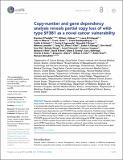| dc.contributor.author | Paolella, Brenton R | |
| dc.contributor.author | Urbanski, Laura M | |
| dc.contributor.author | Alberta, John A | |
| dc.contributor.author | Bandopadhayay, Pratiti | |
| dc.contributor.author | Nichols, Caitlin A | |
| dc.contributor.author | Agarwalla, Pankaj K | |
| dc.contributor.author | Brown, Meredith S | |
| dc.contributor.author | Lamothe, Rebecca | |
| dc.contributor.author | Yu, Yong | |
| dc.contributor.author | Choi, Peter S | |
| dc.contributor.author | Obeng, Esther A | |
| dc.contributor.author | Heckl, Dirk | |
| dc.contributor.author | Vazquez, Francisca | |
| dc.contributor.author | Buhrlage, Sara J | |
| dc.contributor.author | Stiles, Charles D | |
| dc.contributor.author | Reed, Robin | |
| dc.contributor.author | Gibson, William J | |
| dc.contributor.author | Zack, Travis Ian | |
| dc.contributor.author | Wei, Guo | |
| dc.contributor.author | Wang, Belinda | |
| dc.contributor.author | Tsherniak, Aviad | |
| dc.contributor.author | Weir, Barbara A | |
| dc.contributor.author | Root, David | |
| dc.contributor.author | Cowley, Glenn S | |
| dc.contributor.author | Ebert, Benjamin L | |
| dc.contributor.author | Hahn, William | |
| dc.contributor.author | Beroukhim, Rameen | |
| dc.date.accessioned | 2017-06-14T20:35:20Z | |
| dc.date.available | 2017-06-14T20:35:20Z | |
| dc.date.issued | 2017-02 | |
| dc.date.submitted | 2016-11 | |
| dc.identifier.issn | 2050-084X | |
| dc.identifier.uri | http://hdl.handle.net/1721.1/109875 | |
| dc.description.abstract | Genomic instability is a hallmark of human cancer, and results in widespread somatic copy number alterations. We used a genome-scale shRNA viability screen in human cancer cell lines to systematically identify genes that are essential in the context of particular copy-number alterations (copy-number associated gene dependencies). The most enriched class of copy-number associated gene dependencies was CYCLOPS (Copy-number alterations Yielding Cancer Liabilities Owing to Partial losS) genes, and spliceosome components were the most prevalent. One of these, the pre-mRNA splicing factor SF3B1, is also frequently mutated in cancer. We validated SF3B1 as a CYCLOPS gene and found that human cancer cells harboring partial SF3B1 copy-loss lack a reservoir of SF3b complex that protects cells with normal SF3B1 copy number from cell death upon partial SF3B1 suppression. These data provide a catalog of copy-number associated gene dependencies and identify partial copy-loss of wild-type SF3B1 as a novel, non-driver cancer gene dependency. | en_US |
| dc.description.sponsorship | National Cancer Institute (U.S.) (R01 CA188228) | en_US |
| dc.description.sponsorship | National Cancer Institute (U.S.) (U01 CA176058) | en_US |
| dc.description.sponsorship | National Cancer Institute (U.S.) (F30 CA192725) | en_US |
| dc.language.iso | en_US | |
| dc.publisher | eLife Sciences Publications, Ltd. | en_US |
| dc.relation.isversionof | http://dx.doi.org/10.7554/eLife.23268 | en_US |
| dc.rights | Creative Commons Attribution 4.0 International License | en_US |
| dc.rights.uri | http://creativecommons.org/licenses/by/4.0/ | en_US |
| dc.source | eLife | en_US |
| dc.title | Copy-number and gene dependency analysis reveals partial copy loss of wild-type SF3B1 as a novel cancer vulnerability | en_US |
| dc.type | Article | en_US |
| dc.identifier.citation | Paolella, Brenton R; Gibson, William J; Urbanski, Laura M; Alberta, John A; Zack, Travis I; Bandopadhayay, Pratiti; Nichols, Caitlin A et al. “Copy-Number and Gene Dependency Analysis Reveals Partial Copy Loss of Wild-Type SF3B1 as a Novel Cancer Vulnerability.” eLife 6 (February 2017): e23268 © 2017 Paolella et al | en_US |
| dc.contributor.department | Broad Institute of MIT and Harvard | en_US |
| dc.contributor.mitauthor | Gibson, William J | |
| dc.contributor.mitauthor | Zack, Travis Ian | |
| dc.contributor.mitauthor | Wei, Guo | |
| dc.contributor.mitauthor | Wang, Belinda | |
| dc.contributor.mitauthor | Tsherniak, Aviad | |
| dc.contributor.mitauthor | Weir, Barbara A | |
| dc.contributor.mitauthor | Root, David | |
| dc.contributor.mitauthor | Cowley, Glenn S | |
| dc.contributor.mitauthor | Ebert, Benjamin L | |
| dc.contributor.mitauthor | Hahn, William | |
| dc.contributor.mitauthor | Beroukhim, Rameen | |
| dc.relation.journal | eLife | en_US |
| dc.eprint.version | Final published version | en_US |
| dc.type.uri | http://purl.org/eprint/type/JournalArticle | en_US |
| eprint.status | http://purl.org/eprint/status/PeerReviewed | en_US |
| dspace.orderedauthors | Paolella, Brenton R; Gibson, William J; Urbanski, Laura M; Alberta, John A; Zack, Travis I; Bandopadhayay, Pratiti; Nichols, Caitlin A; Agarwalla, Pankaj K; Brown, Meredith S; Lamothe, Rebecca; Yu, Yong; Choi, Peter S; Obeng, Esther A; Heckl, Dirk; Wei, Guo; Wang, Belinda; Tsherniak, Aviad; Vazquez, Francisca; Weir, Barbara A; Root, David E; Cowley, Glenn S; Buhrlage, Sara J; Stiles, Charles D; Ebert, Benjamin L; Hahn, William C; Reed, Robin; Beroukhim, Rameen | en_US |
| dspace.embargo.terms | N | en_US |
| dc.identifier.orcid | https://orcid.org/0000-0003-3159-8175 | |
| dc.identifier.orcid | https://orcid.org/0000-0001-5367-2546 | |
| mit.license | PUBLISHER_CC | en_US |
